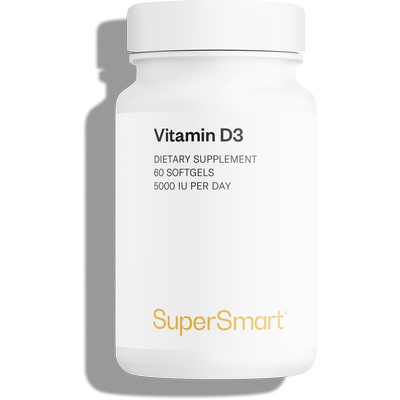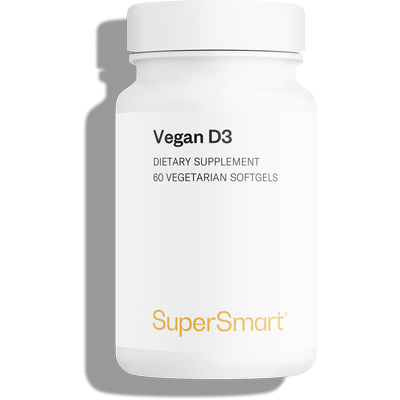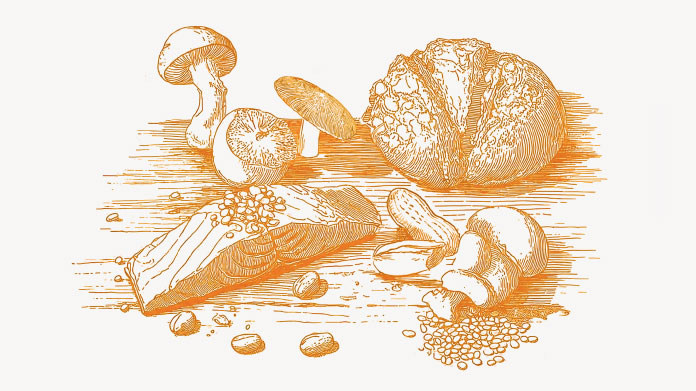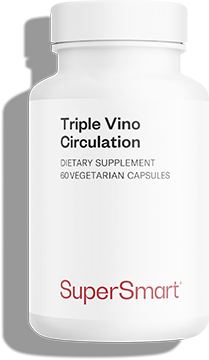
Vitamin D: definition and main benefits
Vitamin D is a fat-soluble vitamin essential for health and vitality. It helps maintain healthy teeth and bones, muscle function and immunity. It also plays a role in the process of cell division.
Let’s take a look at its various sources.
The sun, the main source of vitamin D
First and foremost, vitamin D can be produced by the body under the action of the sun’s rays. Exposing the skin to solar UVB radiation triggers production of vitamin D3, which is subsequently converted in the liver and kidneys into an active hormone, calcitriol.
The sun represents the body’s most important source of vitamin D but in order to be effective, our skin needs to be exposed to it on a regular basis.
A period of 15-30 minutes of exposure a day, especially on the arms and legs, is usually enough to prevent deficiency. However, sun-induced synthesis of vitamin D is heavily influenced by certain factors:
- in the colder months, at certain latitudes far from the equator (such as in Europe), the days are shorter and the sun lower in the sky. The intensity of UVB rays decreases and with it, production of vitamin D;
- and in winter we go out less and cover up more, which can significantly reduce our vitamin D production;
- as we age, our skin becomes less effective at producing vitamin D;
- melanin, a skin pigment, also reduces production of vitamin D. The darker the skin the longer it needs to be exposed (1).
While exposure to the sun is important for promoting vitamin D synthesis, it is not without risk. Protect yourself from ultraviolet rays by wearing good-quality sunglasses, a hat and sun cream (but be aware that applying a cream with too high an SPF throughout the day will also inhibit production of vitamin D) (2).
The best dietary sources of vitamin D
Sun exposure is not the only way of increasing our vitamin D levels. This vitamin is found in several foods.
These are particularly beneficial for preventing deficiency (lack of vitamin D is one of the most common deficiencies in the world), especially during the colder seasons and in regions with low levels of sunlight.
It’s worth knowing that vitamin D2 (or ergocalciferol, from plant sources) is distinct from vitamin D3 (or cholecalciferol, primarily from animal sources). Vitamin D3 is more bioavailable to the body and is also the form we naturally produce when our skin is exposed to the sun.
Oily fish are excellent sources of vitamin D3
Oily fish such as salmon, mackerel and sardines are the best food sources of vitamin D3 (3-4). Wild salmon usually contains the most vitamin D but the amount varies depending on where, and at what time of year, the fish was caught.
Cod liver oil is also known to be a highly-concentrated source of vitamin D.
Offal and eggs
Containing more modest levels, offal such as beef liver, and egg yolks are also reasonable sources of vitamin D3.
Be aware that the animal’s diet and their own exposure to the sun affects the amount of vitamin D present in their tissues or eggs.
Certain mushrooms
Certain (rare) mushrooms such as chanterelle, shiitake, and maitake, are natural sources of vitamin D2.
Their D2 content varies depending on how they are grown and produced. It is affected by the amount and duration of their exposure to UVB rays (some commercially-grown mushrooms are cultivated exclusively in the dark and are thus low in vitamin D).
Foods enriched with vitamin D3
Many products including regular milk, orange juice, plant milks and breakfast cereals may be enriched with vitamin D2 or D3.
Always check the nutritional information on product labels.
Vitamin D supplements
When exposure to the sun and diet fail to provide enough vitamin D, many people turn to dietary supplements to significantly boost their intake.
But which one should you choose? First and foremost, we’d recommend opting for one that contains vitamin D3, the most absorbable form for the body.
Various doses are available depending on your particular needs:
- 5000 IU: a powerful and very effective dose, and one provided by the product Vitamin D3 5000 IU, which comes in the form of softgels for maximum absorption (uptake from softgels being better than from dry forms). It’s also the dose offered by Vegan D3, a supplement made from a GMO-free algae, science having shown that it’s possible to develop vegan vitamin D3 supplements from certain algae;
- 2000 IU: a lower dose but still substantial. This is the dose provided by Vitamin D3 2000 IU, which comes in the form of a sublingual spray which enables the vitamin D3 to enter the bloodstream direct without the risk of malabsorption in the digestive system. This spray is particularly recommended for those with a sensitive stomach;
- 1000 IU: a basic dose but one which suits many people. This is the dose provided by Vitamin D3 1000 IU, which comes in the form of softgels.
SUPERSMART ADVICE
References
- (1) National Library of Medecine - Colour Counts : Sunlight and Skin Type as Drivers of Vitamin D Deficiency at UK Latitudes - Ann R. Webb, Andreas Kazantzidis, Richard C. Kift, Mark D. Farrar, Jack Wilkinson, and Lesley E. Rhodes - Nutrients. 2018 Apr; 10(4): 457.Published online 2018 Apr 7. doi: 10.3390/nu10040457
- (2) Ministère de la Santé et de la Prévention - Risques solaires
- (3) British Heart Foundation - Which foods are high in vitamin D? - Victoria Taylor - Published June 2022
- (4) 7 Nutritious Foods That Are High in Vitamin D - Medically reviewed by Katherine Marengo LDN, R.D., Nutrition — By Taylor Jones, RD — Updated on July 6, 2023
5 Days
Delivery is prompt and I never saw a…
Delivery is prompt and I never saw a quality problem with the manufacturing. It is not possible to assess efficacy on a personal basis, since too many factors come into play. Efficacy can only be assessed statistically with a sufficient number of cases.
Roger De Backer
6 Days
I collaborates with the Supersmart…
I collaborates with the Supersmart more than 10 years. Every thing is going good. Quality of the things is good. Delivery comes in time. Five stars definitely !!!
Oleksiy
6 Days
All good
Simple, frictionless site, easy ordering, good delivery updates and execution.
Chris Robbins
8 Days
I feel better
I feel better
Peter Ammann
8 Days
Prompt delivery
Prompt delivery
JAKUB Radisch
9 Days
My new go-to for top quality supplements!
I am buying more and more of my supplements from this superb, high quality company. Cannot recommend it enough. Plus, excellent customer service with a quick, helpful team and speedy deliveries. Highly recommend Supersmart!
Cecilie H.
13 Days
SUPERSMART WHAT ELSE👍
SUPERSMART WHAT ELSE👍
DIEDERLE Christophe
16 Days
Excellent quality products with…
Excellent quality products with innovative formulas, as someone who has been suffering with acid reflux, these supplements have been lifesavers.
Oriana Moniz
16 Days
high quality supplement!
high quality supplement!
GALANT
16 Days
Good service prompt delivery
Good service prompt delivery
Mrs Marcella Reeves
21 Days
I like your clear explanation
I like your clear explanation. And how to make a choice of products for a specific health problem
Ingrid
28 Days
Great product and it arrives quickly.
Great product and it arrives quickly.
SOMMARIVA Gianni
29 Days
Excellent products and fast service.
Excellent products and fast service. What do we need more?
Margarida
33 Days
The variety of products is amazing
The variety of products is amazing, the offers are good and the sending is very fast. I just miss having a bit more of guidance about combinations, possible interactions, etc.
Maria Angeles Verdu
34 Days
It was quick
It was quick.
Timo Antero









